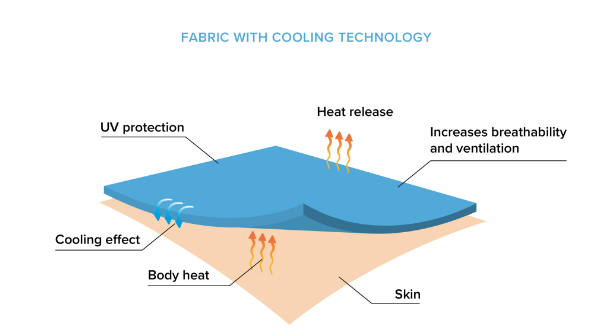Every year, the average temperature on Earth rises and temperatures in major cities around the world reach new records year after year.
Prolonged exposure to high temperatures can be uncomfortable for the body. If our bodies can be cooled by other means, we don’t need to set the air conditioning to very low temperatures, which means that these cooling products make a small contribution to protecting the environment.
The textile industry is doing more and more research and development into cooling fabrics, so there are hundreds of different products, but do you know how these cooling fabrics are made? Join us on this journey to find out more about cooling fabrics!
What is a cooling fabric?
Cooling fabrics are materials that absorb body heat to keep you cool. Cooling fabrics wick moisture away from your body when you sweat, helping to lower your core temperature and prevent dehydration. They also improve blood circulation at the skin’s surface so you can stay cool during exercise.
Which material has the best cooling properties?
Polyester
Polyester fibres have a low moisture content. Thanks to this hydrophobic property, polyester fibres dry quickly, which has a cooling effect. Because the fabric doesn’t absorb water, clothes don’t stick to the skin as easily, creating a cooler feeling. The moisture absorption of polyester fibres is only 0.4%, which means that sweat evaporates quickly without remaining in the yarn or fabric, allowing heat energy to dissipate quickly.
Yarn manufacturers often use these fast-drying properties of polyester fibres to develop moisture-wicking yarns with unique cross-sectional shapes, of which Coolmax yarn is the best known. Compared with conventional round yarns, the structure of this special yarn increases the number of spaces between the fibres while reducing their size. This encourages capillary action, allowing sweat to flow and evaporate more quickly without feeling stuffy.
Nylon
Nylon has a high moisture content and good thermal conductivity, which explains its unique feel and cooling properties. Compared to polyester fibres, which only recover 0.4% moisture, nylon has a moisture content of 4%, giving it better thermal conductivity. However, this high percentage of moisture recovery means that its hydrophobic properties are not as good, so it dries more slowly than polyester.
As a result, some lightweight, thin nylon fabrics, even if they have no additional cooling properties, can still feel cool on contact when used indoors. This high moisture absorption capacity of nylon is often enhanced by manufacturers to improve the contact cooling effect.
Texture of cooling fabrics
Even with cooling yarns, its cooling properties are impaired if the fabric from which it is made is thick and dense. It is therefore important to ensure that fabrics are lightweight, less dense or even knitted at the design stage. Lightweight fabrics dry more quickly when they come into contact with perspiration, and the faster they dry, the more likely it is that our bodies will be cooled by evaporation.
Conclusion
There are many types of cooling garments on the market today. Each fabric is made up of different materials that are arranged in a unique way and using different techniques, so that they produce a cooling effect in different ways.
A better understanding of cooling fabrics before designing garments can help us to choose more appropriate fabrics and create better design plans. We hope that the above explanations will help you to better understand cooling fabrics!
If you are interested in cooling fabrics, welcome to contact us. Fuzhou Huasheng Textile., Ltd is committed to providing the high quality fabric and best service to the customer worldwide.
Post time: Mar-07-2024
